Convolution of Barker and Mutually Orthogonal Golay Complementary Codes for Ultrasonic Testing
Abstract
1. Introduction
2. Methodology
2.1. Barker Codes
2.2. MOGCC
2.3. BMOGCC
2.4. Performance Evaluation of Codes
3. Numerical Simulations
3.1. Finite Element Modeling
3.2. Results of Decoding
4. Experimental Measurements
4.1. Experimental Setup
4.2. Results of Decoding
5. Discussion
- BMOGCC retains the low sidelobe levels of Barker codes and the double time efficiency of MOGCC, offering a key advantage over CGC and BCGC, which require two sequential transmissions.
- BMOGCC also provides a higher mainlobe amplitude than both Barker codes and MOGCC, even at shorter lengths, allowing more flexibility in signal design.
- Finally, BMOGCC preserves the temporal resolution, making it suitable for imaging applications where resolution is critical.
6. Conclusions
Author Contributions
Funding
Institutional Review Board Statement
Informed Consent Statement
Data Availability Statement
Acknowledgments
Conflicts of Interest
References
- Tolbert, C.L. Leveraging variable frequency drive data for nondestructive testing and predictive maintenance in industrial systems. NDT 2025, 3, 7. [Google Scholar] [CrossRef]
- Khatun, H.; Hazarika, S.; Sarma, U. Aluminium plate surface defect detection and classification based on piezoelectric transducers. In Proceedings of the 2021 IEEE 18th India Council International Conference (INDICON), Guwahati, India, 19–21 December 2021; pp. 1–6. [Google Scholar] [CrossRef]
- Peng, C.; Annus, P.; Rist, M.; Land, R.; Ratassepp, M. Fractional fourier transform-based signal separation for ultrasonic guided wave inspection of plates. Sensors 2024, 24, 7564. [Google Scholar] [CrossRef]
- Rasgado-Moreno, C.O.; Rist, M.; Land, R.; Ratassepp, M. Guided wave tomography of pipe bends based on full waveform inversion. Ultrasonics 2025, 148, 107560. [Google Scholar] [CrossRef]
- Sarabia, E.G.; Llata, J.R.; Robla, S.; Torre-Ferrero, C.; Oria, J.P. Accurate estimation of airborne ultrasonic time-of-flight for overlapping echoes. Sensors 2013, 13, 15465–15488. [Google Scholar] [CrossRef]
- Kong, K.; Dyer, K.; Payne, C.; Hamerton, I.; Weaver, P.M. Progress and trends in damage detection methods, maintenance, and data-driven monitoring of wind turbine blades—A review. Renew. Energy Focus 2023, 44, 390–412. [Google Scholar] [CrossRef]
- Wei, X.; Yang, Y.; Ureña, J.; Yan, J.; Wang, H. An adaptive peak detection method for inspection of breakages in long rails by using Barker coded UGW. IEEE Access 2020, 8, 48529–48542. [Google Scholar] [CrossRef]
- Simon, L.H.; Wilkens, V.; Beyer, M. Safety-related conclusions for the application of ultrasound in explosive atmospheres. J. Loss Prev. Process Ind. 2015, 36, 522–531. [Google Scholar] [CrossRef]
- Chiao, R.; Hao, X. Coded excitation for diagnostic ultrasound: A system developer’s perspective. IEEE Trans. Ultrason. Ferroelectr. Freq. Control 2005, 52, 160–170. [Google Scholar] [CrossRef]
- Misaridis, A. Ultrasound Imaging Using Coded Signals. Ph.D. Thesis, Technical University of Denmark, Lyngby, Denmark, 2001. [Google Scholar]
- Kiefer, D.A.; Fink, M.; Rupitsch, S.J. Simultaneous ultrasonic measurement of thickness and speed of sound in elastic plates using coded excitation signals. IEEE Trans. Ultrason. Ferroelectr. Freq. Control 2017, 64, 1744–1757. [Google Scholar] [CrossRef] [PubMed]
- Takeuchi, Y. An investigation of a spread energy method for medical ultrasound systems: Part one: Theory and investigation. Ultrasonics 1979, 17, 175–182. [Google Scholar] [CrossRef]
- Gan, T.; Hutchins, D.; Billson, D.; Schindel, D. The use of broadband acoustic transducers and pulse-compression techniques for air-coupled ultrasonic imaging. Ultrasonics 2001, 39, 181–194. [Google Scholar] [CrossRef]
- Eckersley, R.J.; Chin, C.T.; Burns, P.N. Optimising phase and amplitude modulation schemes for imaging microbubble contrast agents at low acoustic power. Ultrasound Med. Biol. 2005, 31, 213–219. [Google Scholar] [CrossRef]
- Jiang, X.; Wang, J.; Zhang, Y.; Jiang, S. Defect detection in solid timber panels using air-coupled ultrasonic imaging techniques. Appl. Sci. 2024, 14, 434. [Google Scholar] [CrossRef]
- Xia, S.; Li, Z.P.; Jiang, C.L.; Wang, S.J.; Wang, K.C. Application of pulse compression technology in electromagnetic ultrasonic thickness measurement. In Proceedings of the 2018 IEEE Far East NDT New Technology & Application Forum (FENDT), Xiamen, China, 6–8 July 2018; pp. 37–41. [Google Scholar] [CrossRef]
- Garcia-Rodriguez, M.; Yañez, Y.; Garcia-Hernandez, M.; Salazar, J.; Turo, A.; Chavez, J. Application of Golay codes to improve the dynamic range in ultrasonic Lamb waves air-coupled systems. NDT E Int. 2010, 43, 677–686. [Google Scholar] [CrossRef]
- Germano, E.; Tabatabaeipour, M.; Mohseni, E.; Lines, D.; MacLeod, C.N.; Lam, K.H.; Hughes, D.; Trodden, H.; Gachagan, A. Application of Golay-based total focusing method using a high-frequency, lead-free, flexible ultrasonic array for inspection of thick non-planar industrial components. NDT E Int. 2025, 150, 103282. [Google Scholar] [CrossRef]
- Fan, Z.; Rudlin, J.; Asfis, G.; Meng, H. Convolution of Barker and Golay codes for low voltage ultrasonic testing. Technologies 2019, 7, 72. [Google Scholar] [CrossRef]
- Weng, C.; Gu, X.; Jin, H. Coded excitation for ultrasonic testing: A review. Sensors 2024, 24, 2167. [Google Scholar] [CrossRef]
- Kim, B.H.; Kim, G.D.; Song, T.K. A post-compression based ultrasound imaging technique for simultaneous transmit multi-zone focusing. Ultrasonics 2007, 46, 148–154. [Google Scholar] [CrossRef]
- Nowicki, A.; Trots, I.; Secomski, W.; Litniewski, J. Golay’s codes sequences in ultrasonography. Hydroacoustics 2004, 7, 173–182. [Google Scholar]
- Kim, P.; Jung, E.; Bae, S.; Kim, K.; Song, T. Barker-sequence-modulated golay coded excitation technique for ultrasound imaging. In Proceedings of the 2016 IEEE International Ultrasonics Symposium (IUS), Tours, France, 18–21 September 2016; pp. 1–4. [Google Scholar] [CrossRef]
- Fan, Z.; Niu, X.; Miao, B.; Meng, H. Hybrid coded excitation of the torsional guided wave mode T(0,1) for Oil and gas pipeline inspection. Appl. Sci. 2022, 12, 777. [Google Scholar] [CrossRef]
- Yang, Y.; Wang, P.; Jia, Y.; Jing, L.; Shi, Y.; Sheng, H.; Jiang, Y.; Liu, R.; Xu, Y.; Li, X. Rail fracture monitoring based on ultrasonic-guided wave technology with multivariate coded excitation. Ultrasonics 2024, 136, 107164. [Google Scholar] [CrossRef] [PubMed]
- Trots, I. Mutually orthogonal Golay complementary sequences in synthetic aperture imaging systems. Arch. Acoust. 2015, 40, 283–289. [Google Scholar] [CrossRef][Green Version]
- Tasinkevych, Y.; Trots, I.; Nowicki, A. Mutually orthogonal Golay complementary sequences in the simultaneous synthetic aperture method for medical ultrasound diagnostics. An experimental study. Ultrasonics 2021, 115, 106434. [Google Scholar] [CrossRef] [PubMed]
- Cook, C. Radar Signals: An Introduction to Theory and Application; Elsevier: Amsterdam, The Netherlands, 2012. [Google Scholar]
- Tang, J.; Zhu, W.; Qiu, X.; Song, A.; Xiang, Y.; Xuan, F.Z. Non-contact phase coded excitation of ultrasonic Lamb wave for blind hole inspection. Ultrasonics 2022, 119, 106606. [Google Scholar] [CrossRef] [PubMed]
- Laroche, N.; Bourguignon, S.; Carcreff, E.; Idier, J.; Duclos, A. An inverse approach for ultrasonic imaging from full matrix capture data: Application to resolution enhancement in NDT. IEEE Trans. Ultrason. Ferroelectr. Freq. Control 2020, 67, 1877–1887. [Google Scholar] [CrossRef]
- Holmes, C.; Drinkwater, B.W.; Wilcox, P.D. Post-processing of the full matrix of ultrasonic transmit–receive array data for non-destructive evaluation. NDT E Int. 2005, 38, 701–711. [Google Scholar] [CrossRef]
- Smith, M. ABAQUS/Standard User’s Manual; Version 6.9; Dassault Systèmes Simulia Corp: Waltham, MA, USA, 2009. [Google Scholar]
- Hamam, Z.; Godin, N.; Fusco, C.; Monnier, T. Modelling of acoustic emission signals due to fiber break in a model composite carbon/epoxy: Experimental validation and parametric study. Appl. Sci. 2019, 9, 5124. [Google Scholar] [CrossRef]
- Rasgado-Moreno, C.O.; Rist, M.; Land, R.; Ratassepp, M. Acoustic Forward Model for Guided Wave Propagation and Scattering in a Pipe Bend. Sensors 2022, 22, 486. [Google Scholar] [CrossRef]


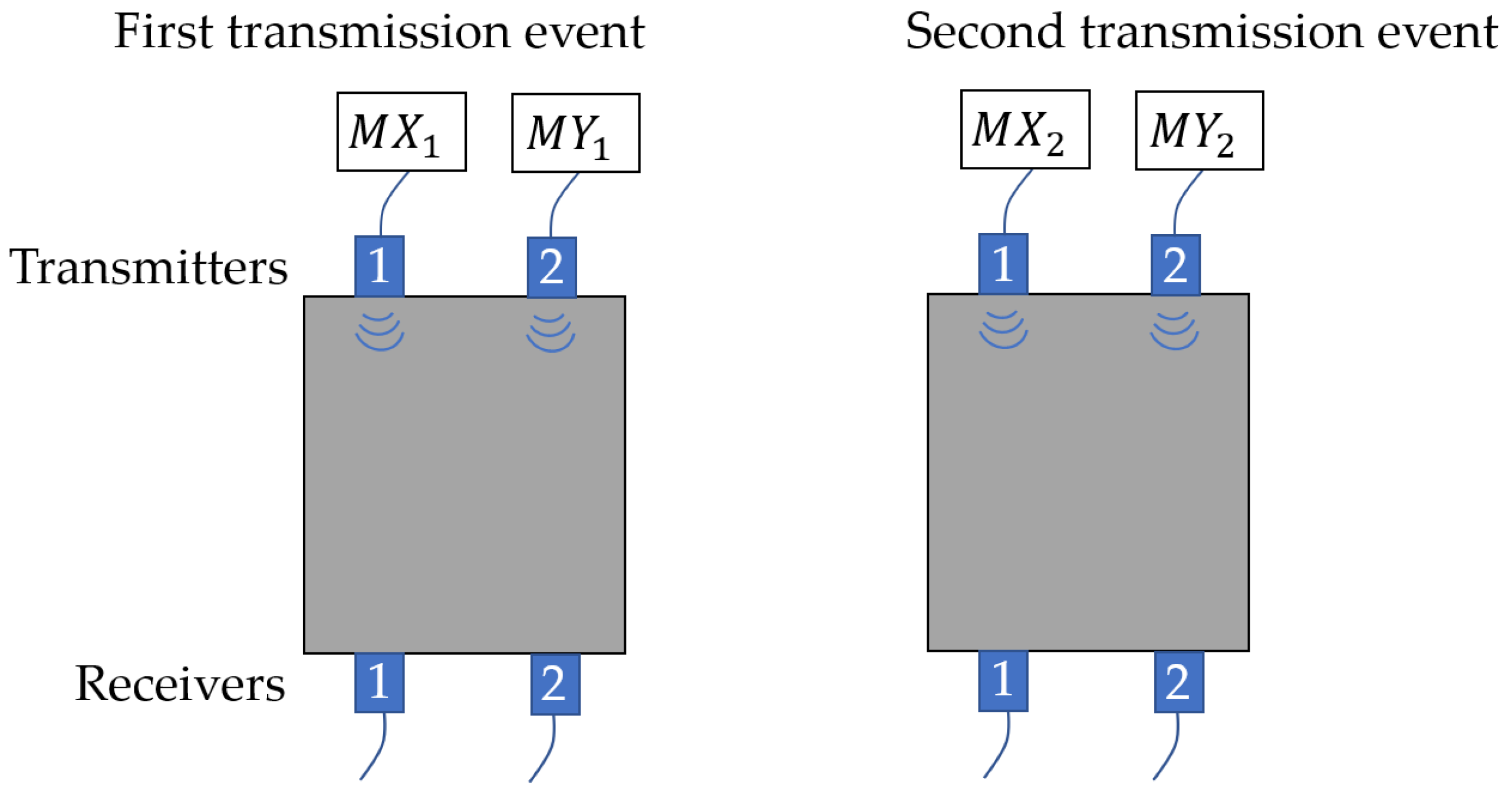
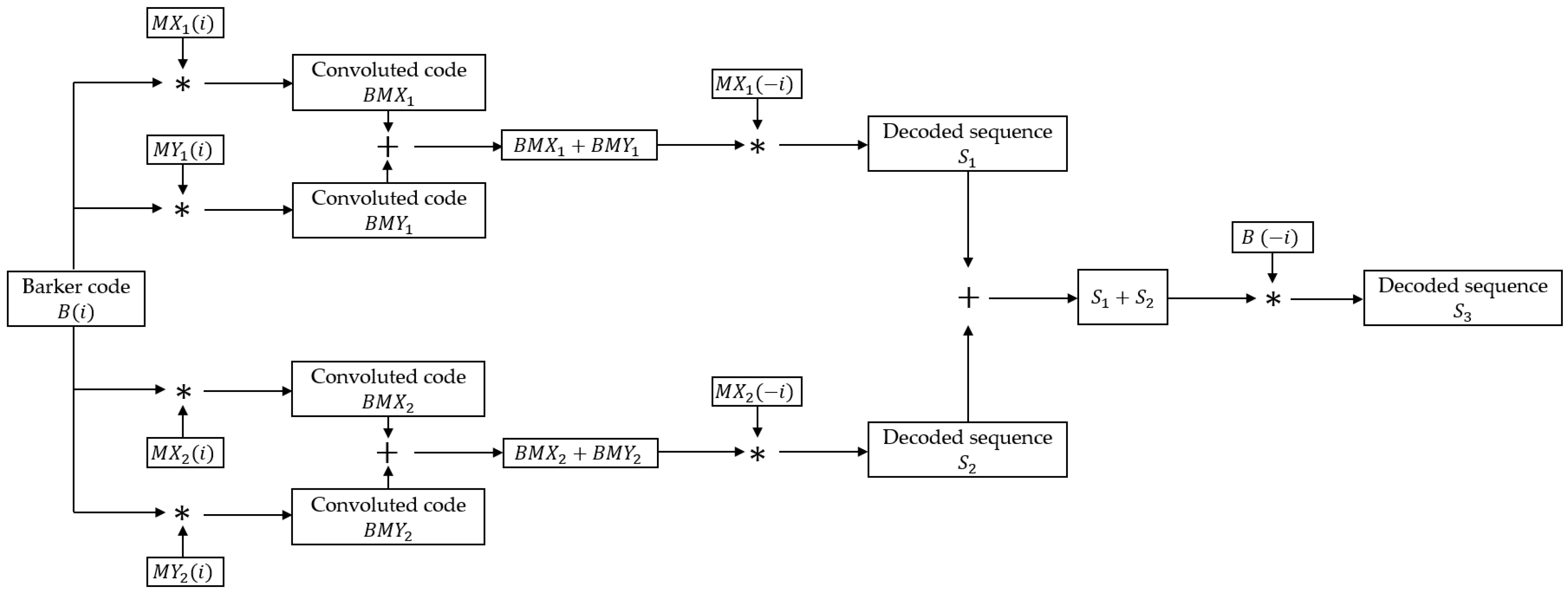
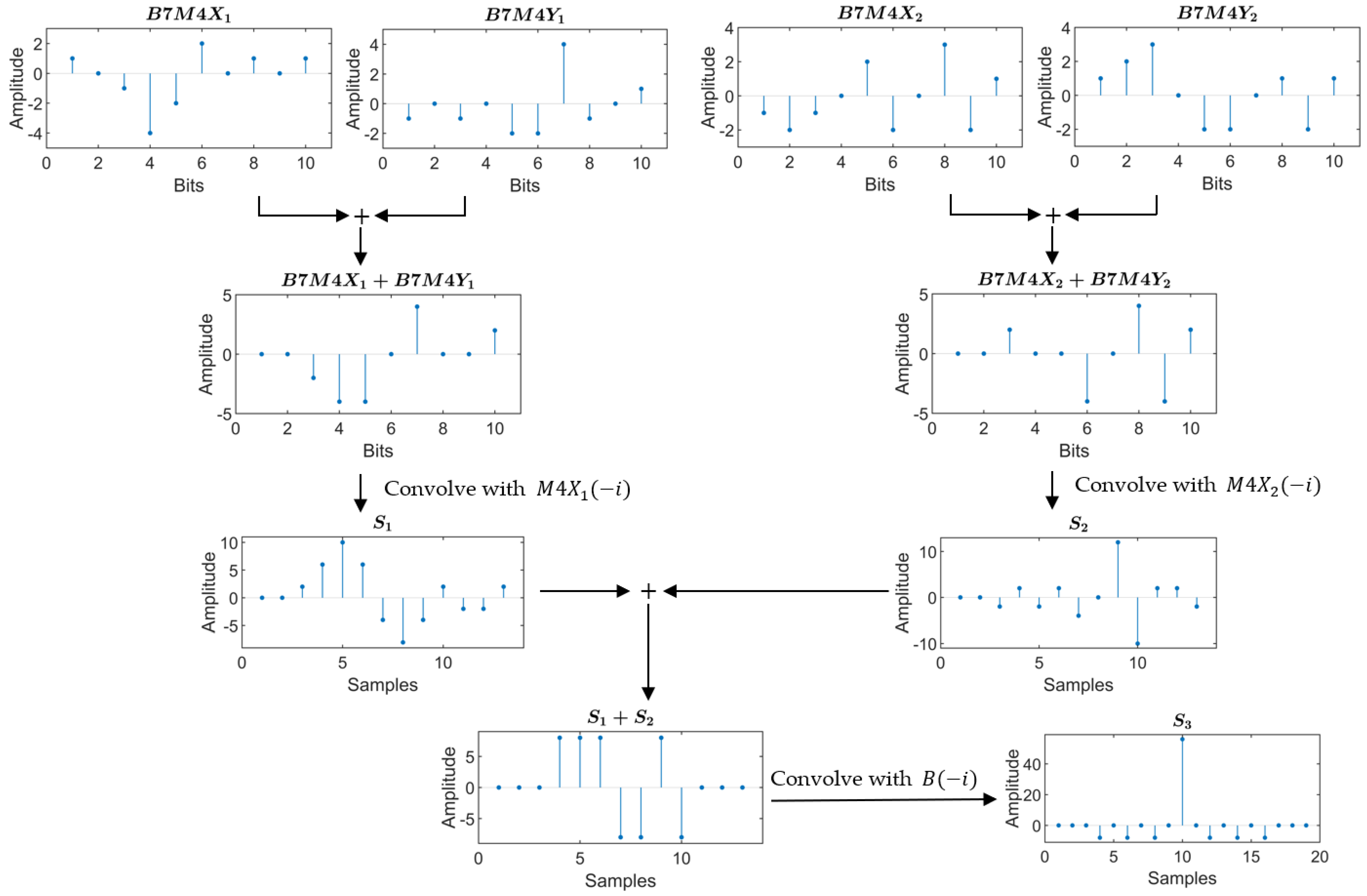
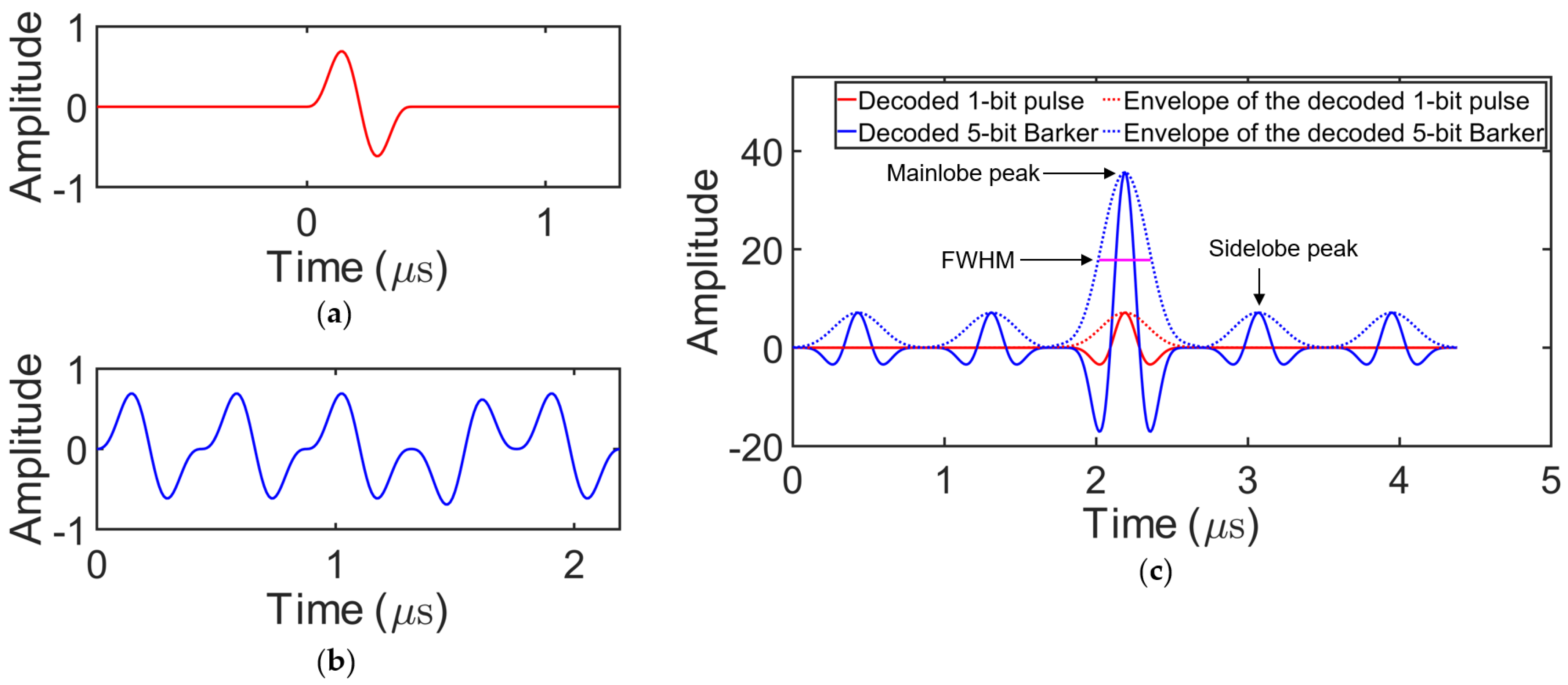
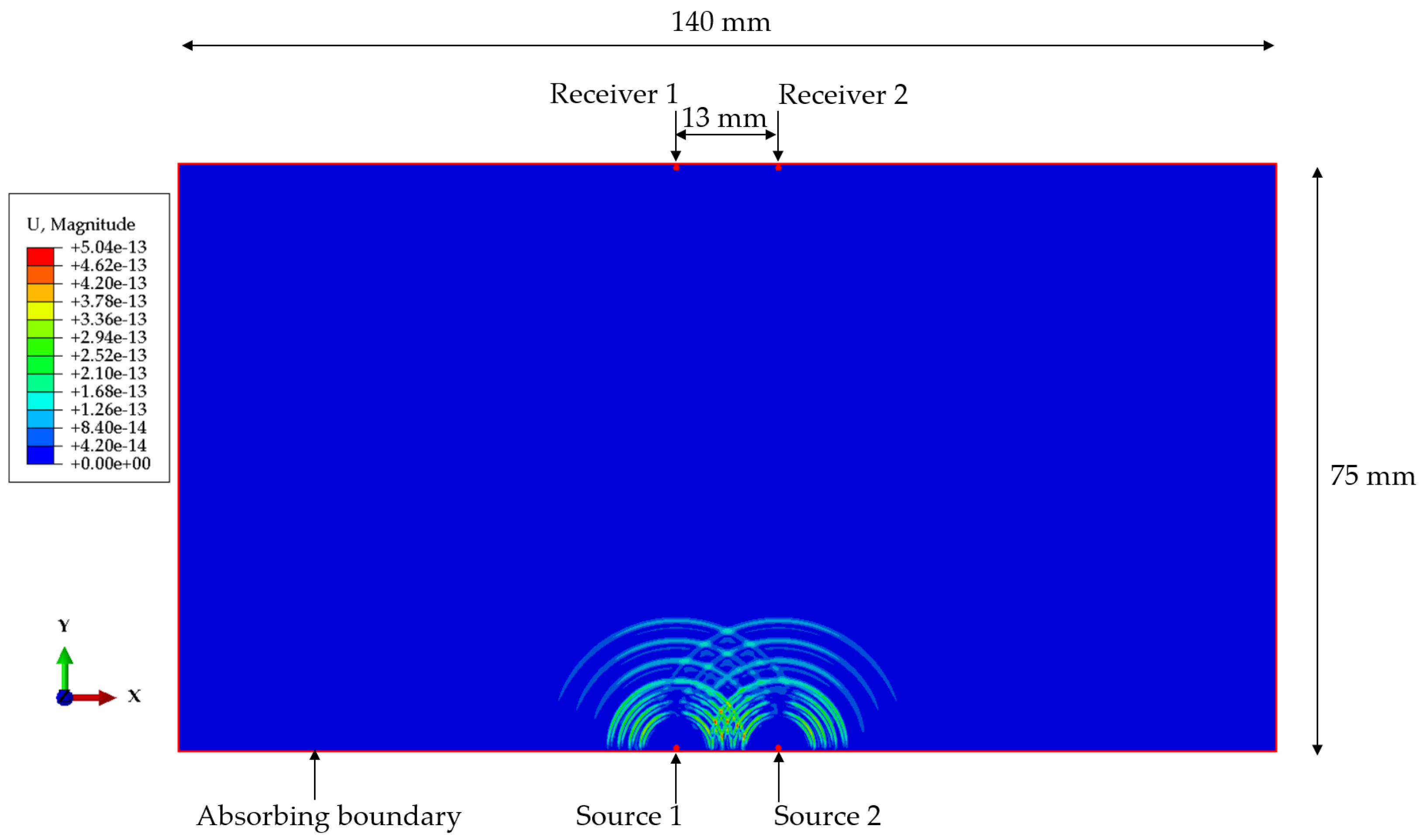
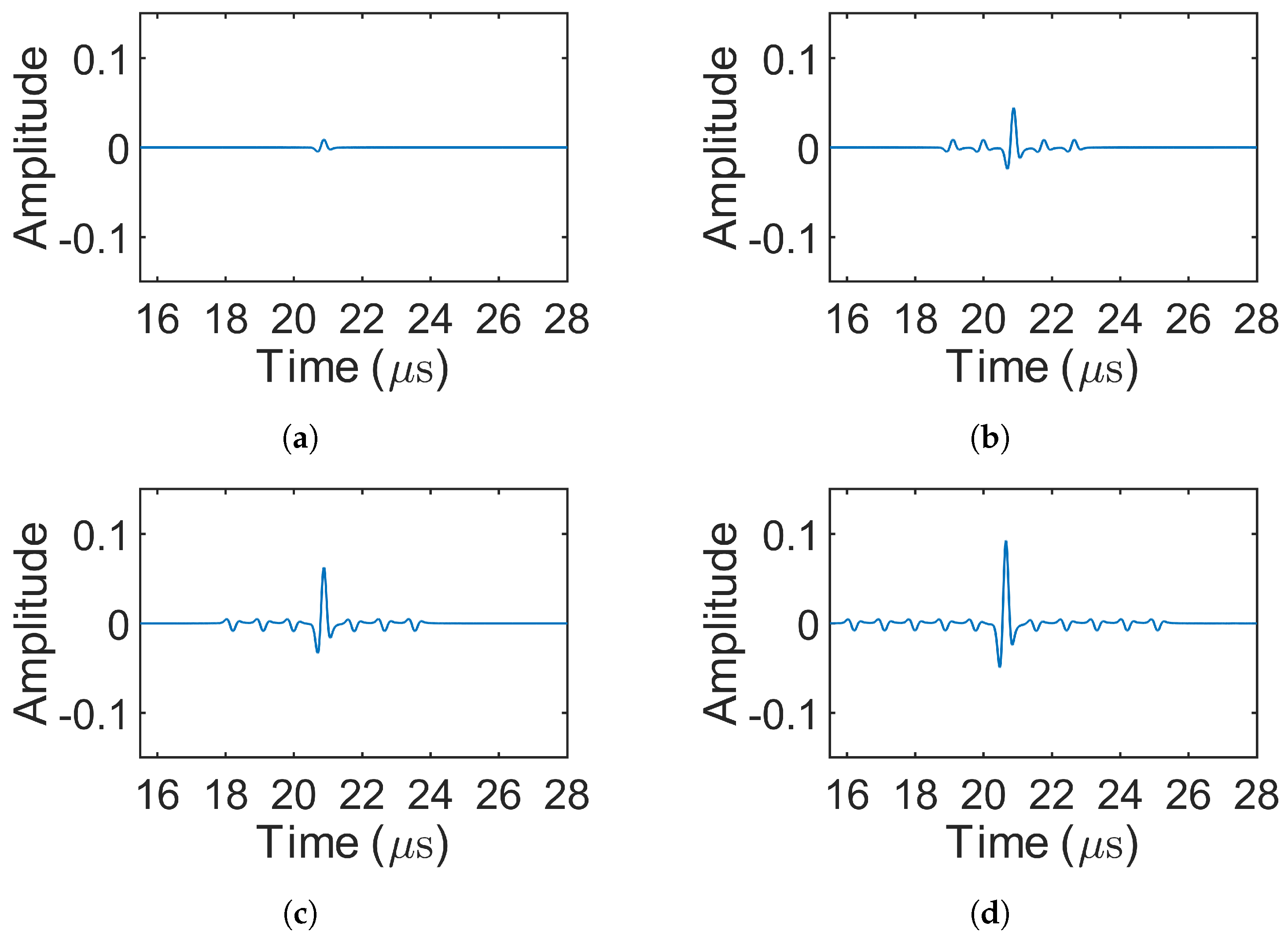
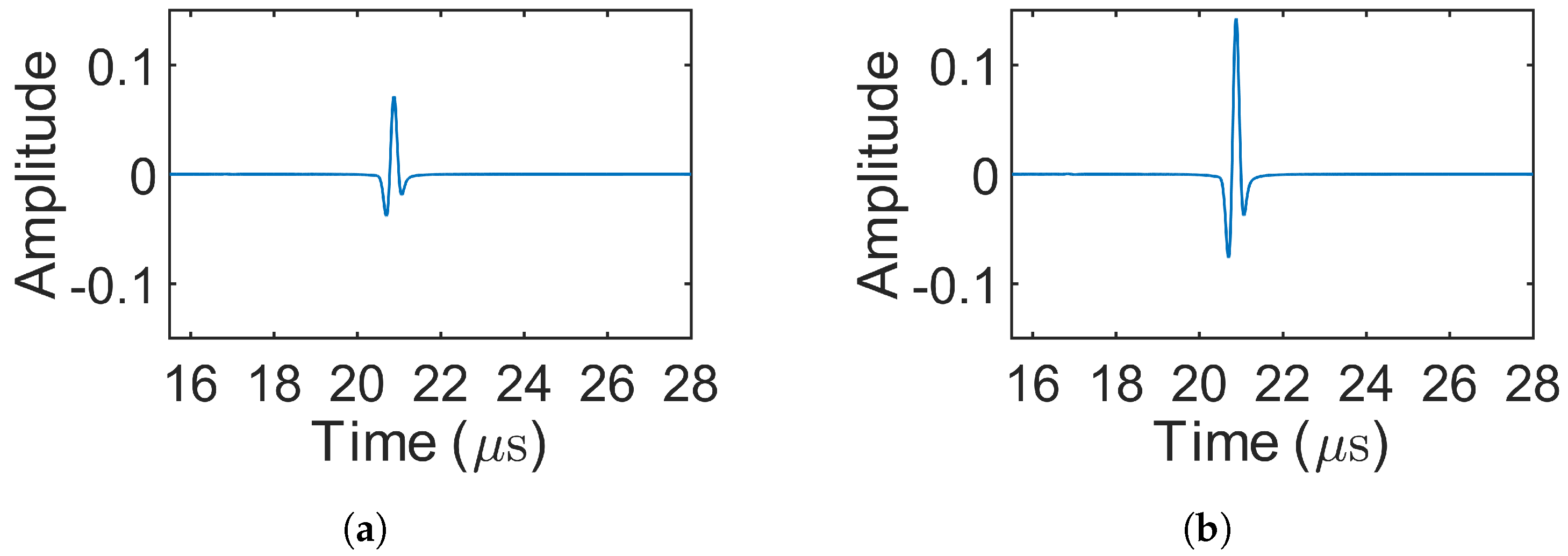
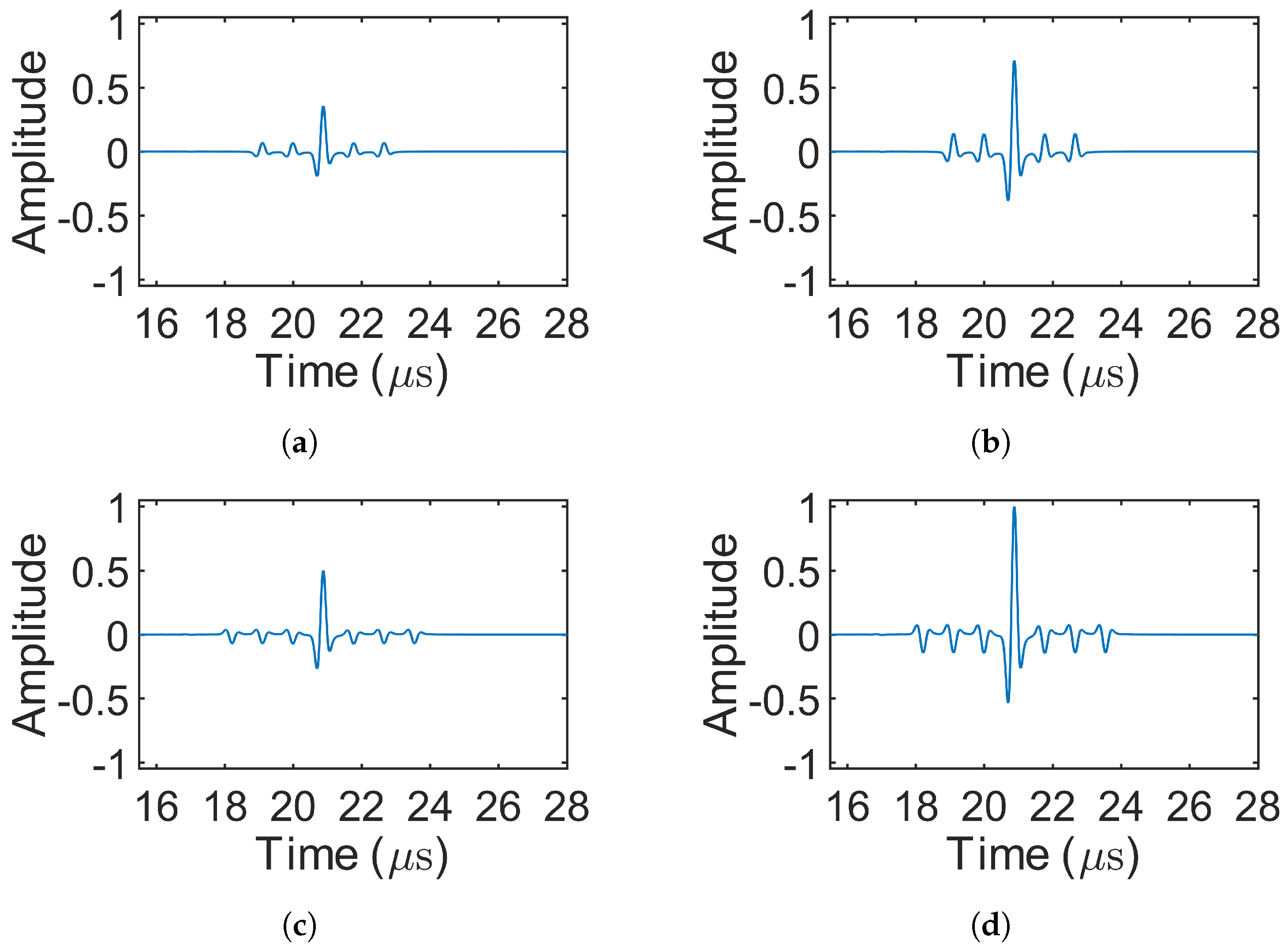
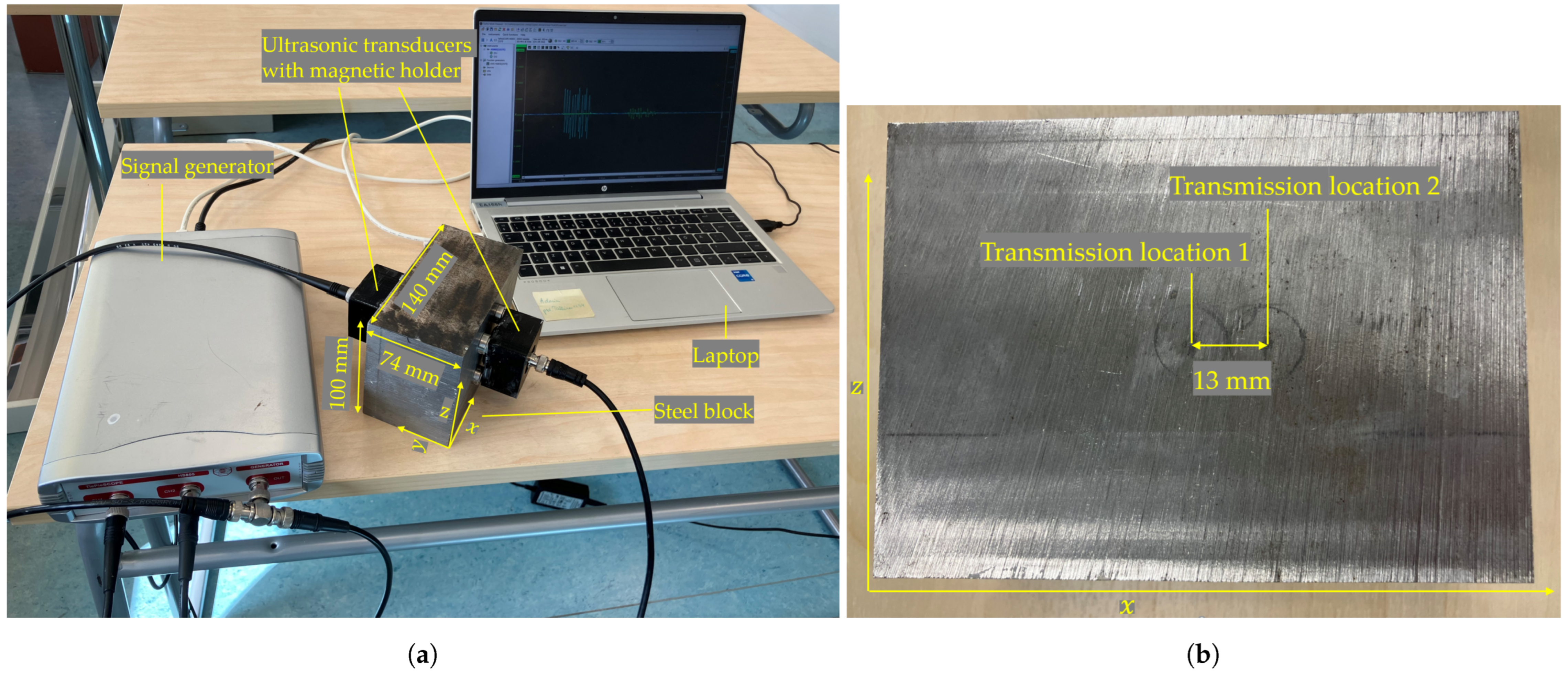
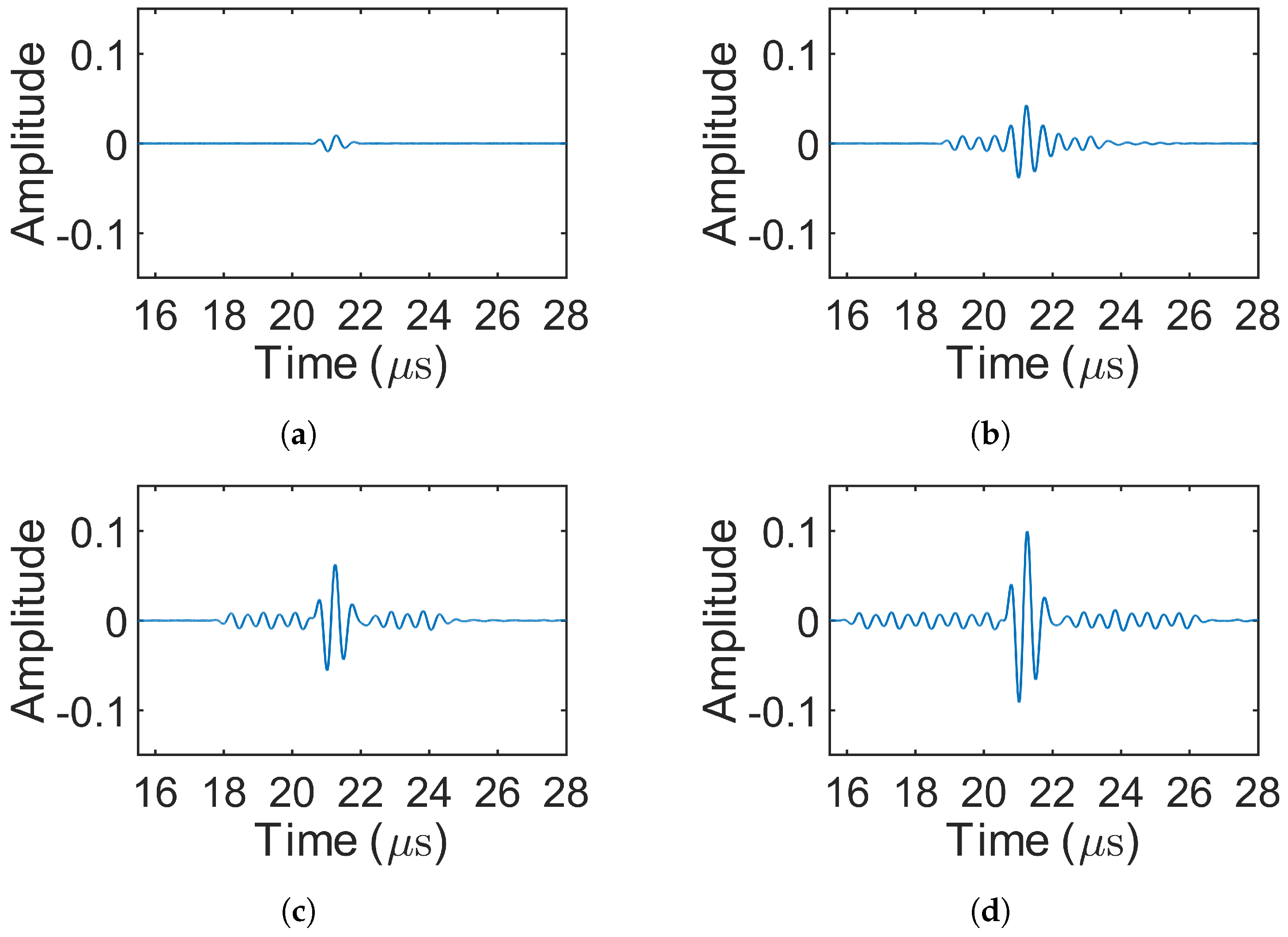
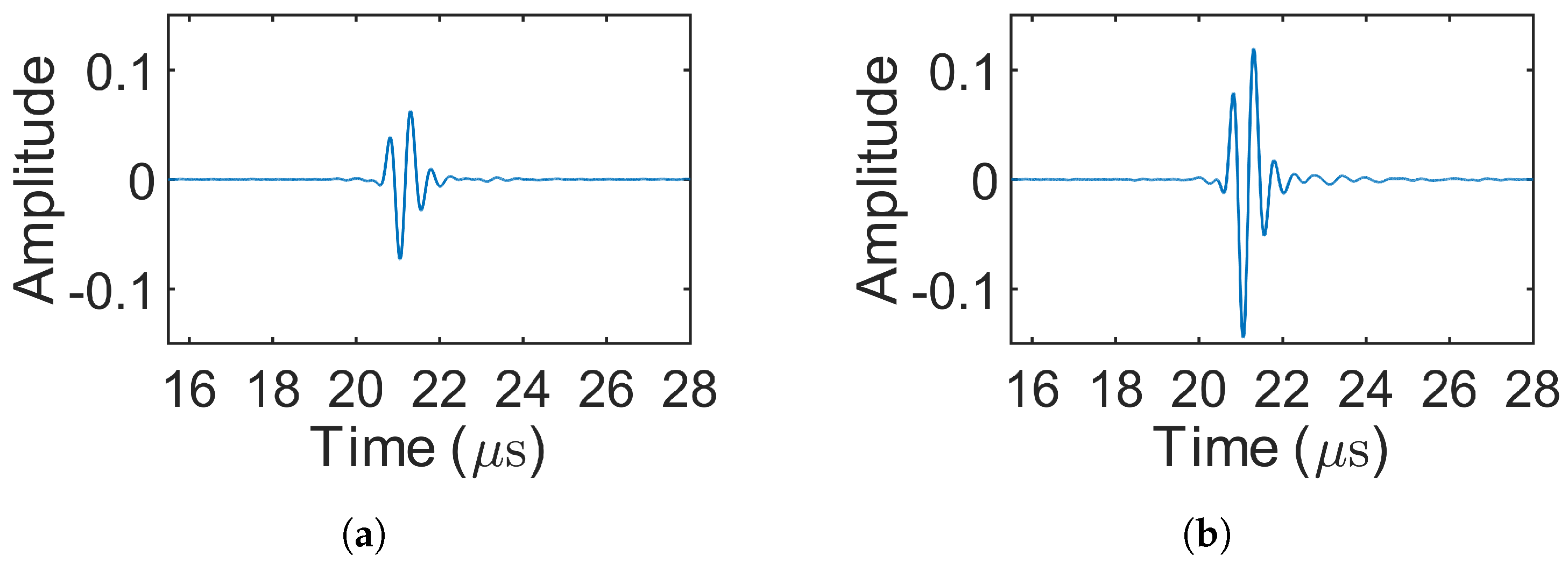
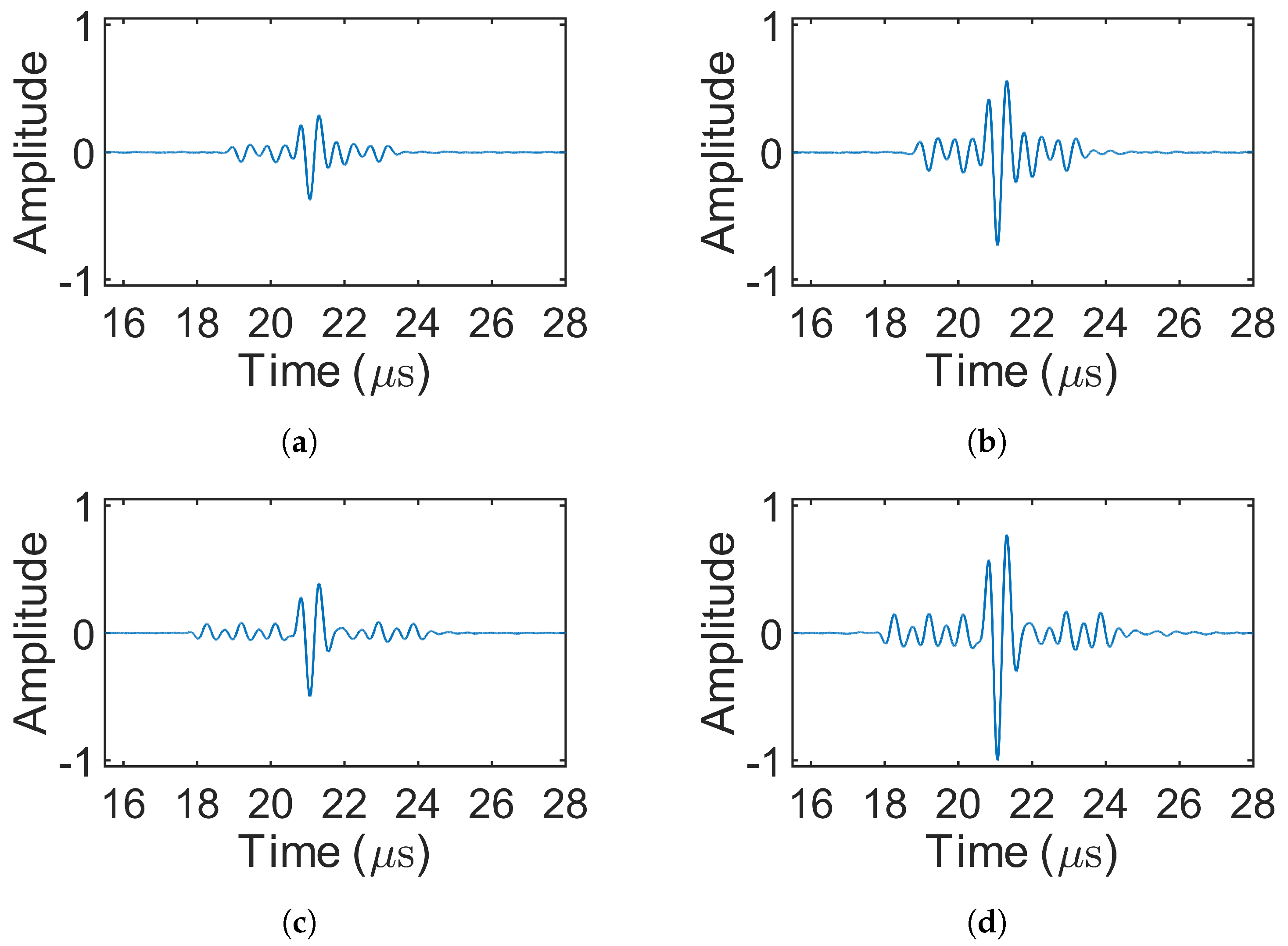
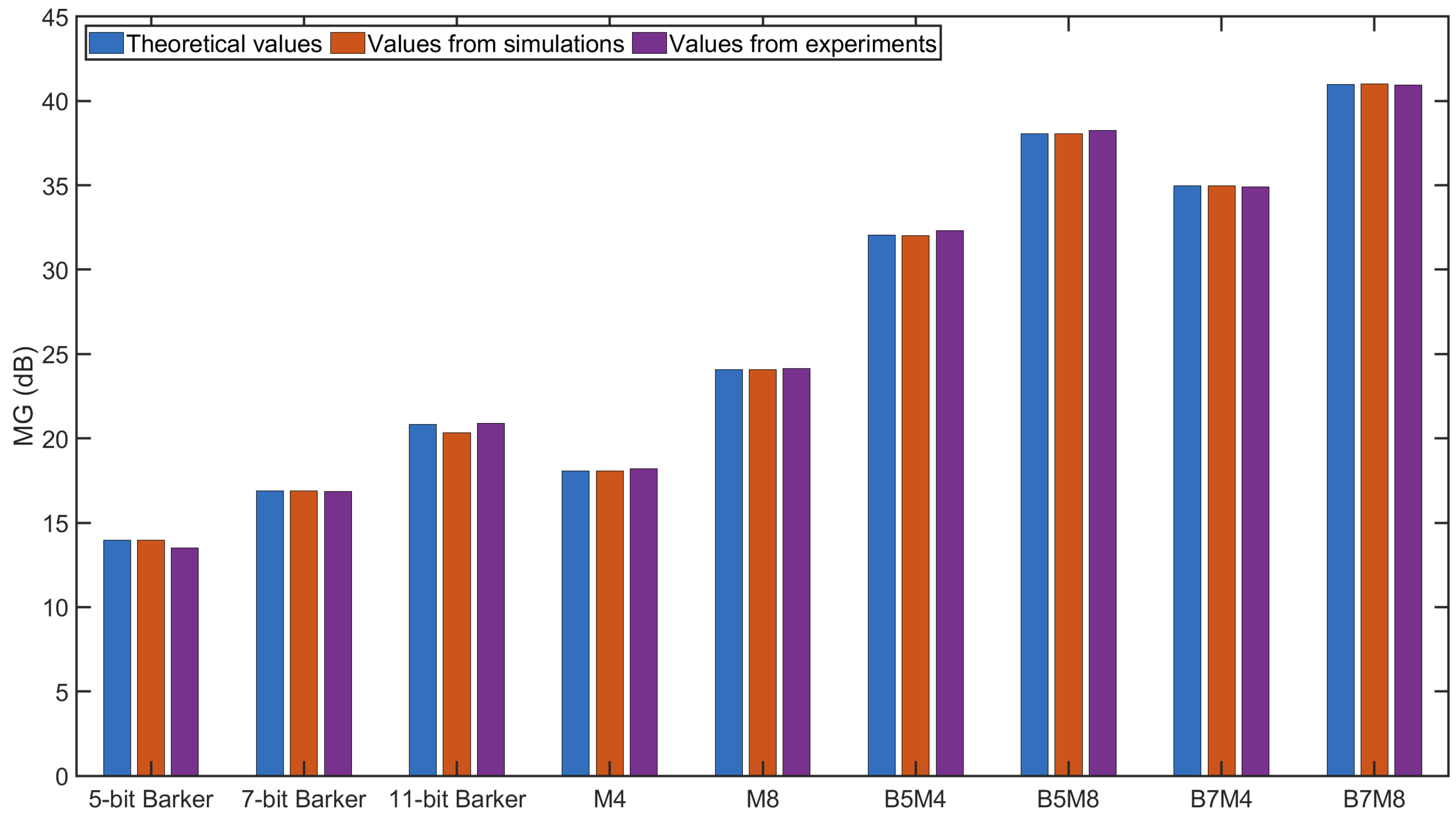
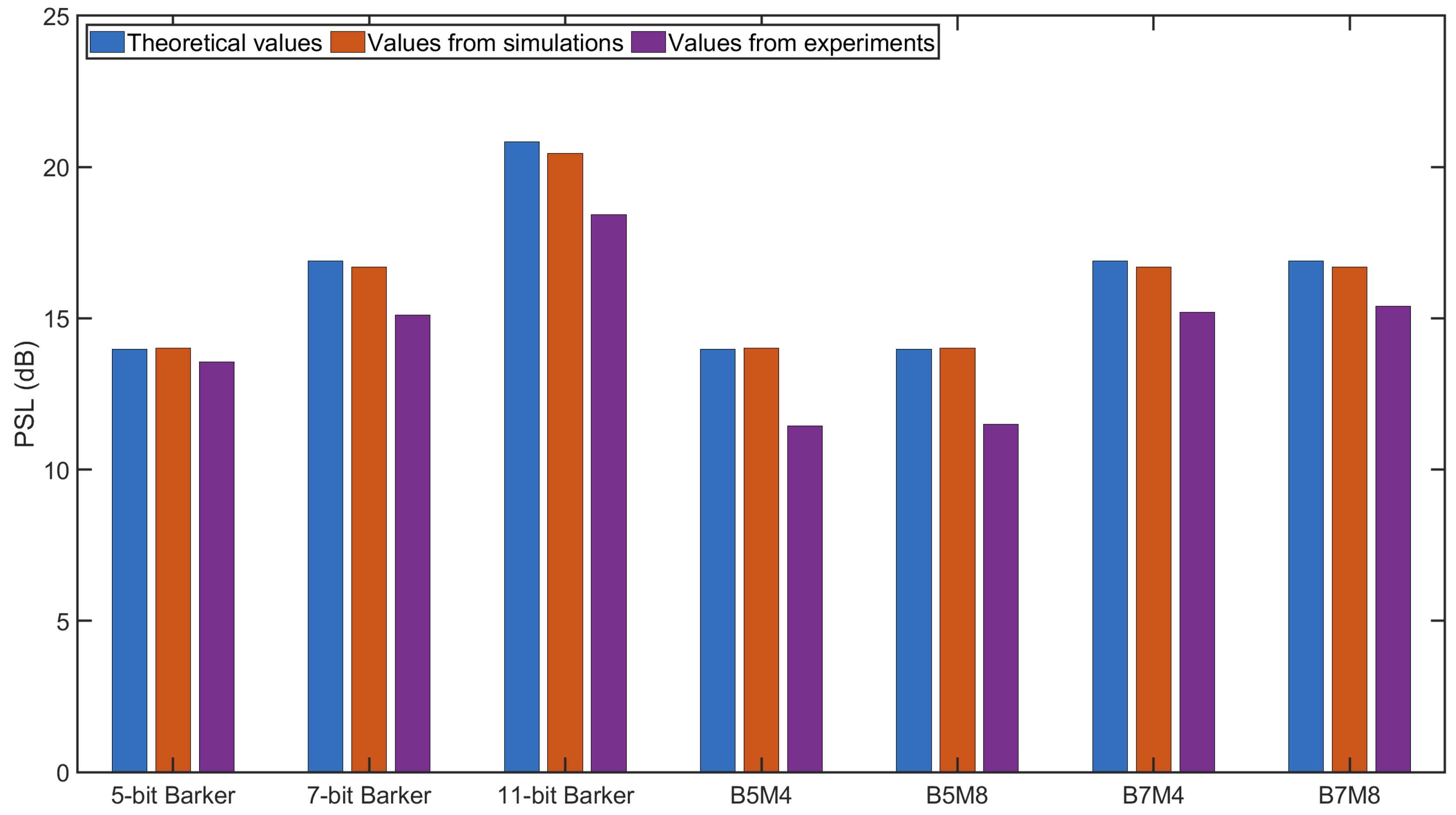
| Coded Sequence Notation | Code Bit Value | |
|---|---|---|
| 2 | or | |
| 3 | ||
| 4 | or | |
| 5 | ||
| 7 | ||
| 11 | ||
| 13 |
| Coded Sequence Notation | Code Bit Value |
|---|---|
| Code | Length | PSL | MG |
|---|---|---|---|
| Barker | |||
| CGC | - | ||
| MOGCC | - | ||
| BMOGCC |
| Young’s Modulus | Poisson Ratio | Density |
|---|---|---|
| 195 GPa |
| Simulation No. | Code | Source 1 | Source 2 |
|---|---|---|---|
| 1 | - | 1-bit pulse | - |
| 2 | Barker | - | |
| 3 | Barker | - | |
| 4 | Barker | - | |
| 5 | M4 | ||
| 6 | M4 | ||
| 7 | M8 | ||
| 8 | M8 | ||
| 9 | B5M4 | ||
| 10 | B5M4 | ||
| 11 | B5M8 | ||
| 12 | B5M8 | ||
| 13 | B7M4 | ||
| 14 | B7M4 | ||
| 15 | B7M8 | ||
| 16 | B7M8 |
| Excitation Signal | FWHM of Simulations (μs) | FWHM of Experiments (μs) |
|---|---|---|
| 1-bit Pulse | 0.35 | 0.75 |
| 5-bit Barker | 0.35 | 0.89 |
| 7-bit Barker | 0.35 | 0.78 |
| 11-bit Barker | 0.35 | 0.78 |
| M4 | 0.35 | 0.70 |
| M8 | 0.35 | 0.69 |
| B5M4 | 0.35 | 0.68 |
| B5M8 | 0.35 | 0.67 |
| B7M4 | 0.35 | 0.67 |
| B7M8 | 0.35 | 0.68 |
Disclaimer/Publisher’s Note: The statements, opinions and data contained in all publications are solely those of the individual author(s) and contributor(s) and not of MDPI and/or the editor(s). MDPI and/or the editor(s) disclaim responsibility for any injury to people or property resulting from any ideas, methods, instructions or products referred to in the content. |
© 2025 by the authors. Licensee MDPI, Basel, Switzerland. This article is an open access article distributed under the terms and conditions of the Creative Commons Attribution (CC BY) license (https://creativecommons.org/licenses/by/4.0/).
Share and Cite
Peng, C.; Annus, P.; Rist, M.; Land, R.; Ratassepp, M. Convolution of Barker and Mutually Orthogonal Golay Complementary Codes for Ultrasonic Testing. Sensors 2025, 25, 5007. https://doi.org/10.3390/s25165007
Peng C, Annus P, Rist M, Land R, Ratassepp M. Convolution of Barker and Mutually Orthogonal Golay Complementary Codes for Ultrasonic Testing. Sensors. 2025; 25(16):5007. https://doi.org/10.3390/s25165007
Chicago/Turabian StylePeng, Chengxiang, Paul Annus, Marek Rist, Raul Land, and Madis Ratassepp. 2025. "Convolution of Barker and Mutually Orthogonal Golay Complementary Codes for Ultrasonic Testing" Sensors 25, no. 16: 5007. https://doi.org/10.3390/s25165007
APA StylePeng, C., Annus, P., Rist, M., Land, R., & Ratassepp, M. (2025). Convolution of Barker and Mutually Orthogonal Golay Complementary Codes for Ultrasonic Testing. Sensors, 25(16), 5007. https://doi.org/10.3390/s25165007






